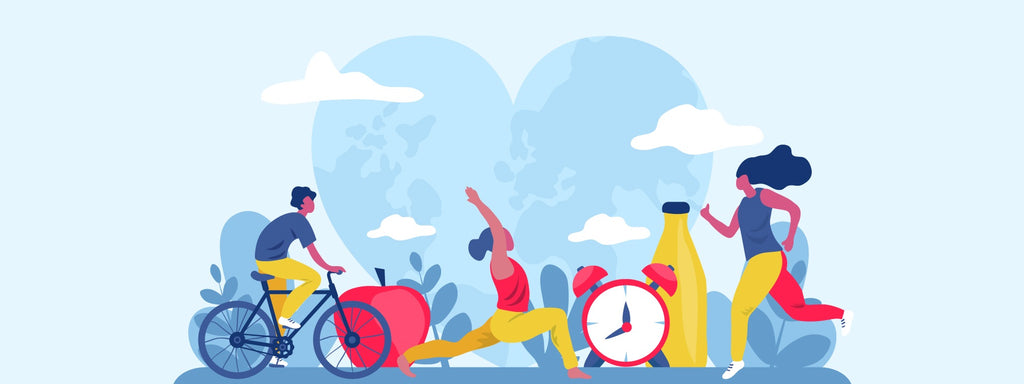Heavy bleeding, menstrual pain, and deviations in your menstrual cycle are characteristics familiar to most menstruators. However, unusual or abnormal increase or change in these things hints that a visit to your gynaecologist is in order! This World Health Day, let’s work to normalise and destigmatize menstrual problems, because no, it does not happen to everyone, and no, it is not okay. So, here is a list of menstrual disorders which are very common in India!

Amenorrhea - When a menstruator experiences no periods at all, that is termed as amenorrhea. This is mainly characterized by complete lack of menstrual bleeding, but it does not mean that the person is infertile. It may be caused due to menopause, pregnancy, use of birth control, delayed puberty or/and stress.
Dysmenorrhea - Period cramps are no strangers to most menstruators. However, if the period pain is unusually painful and persistent, one may be suffering from dysmenorrhea. Dysmenorrhea may bring a heavy flow, clots, uterine fibroids, or endometriosis.
Pre menstrual syndrome (PMS) - PMS is the combination of emotional, psychological and physical changes that take place in a menstruator’s body. PMS may start a week before the menstrual cycle and end with the onset of the menstrual cycle or soon after. Common symptoms include bloating, cramps, mood swings, fatigue and food cravings.
Pre menstrual dysphoric disorder (PMDD) - PMDD is basically PMS, but on a more serious and extreme level, thereby interfering with a menstruator’s daily activities. This causes physical and behavioral changes that usually resolve with the onset of your period. It causes extreme mood swings which can be disruptive, and a few of its symptoms are irritability, extreme sadness, anger and hopelessness.
Polycystic ovarian syndrome (PCOS) - PCOS is a hormonal disorder causing enlarged ovaries with small cysts on the outer edges. Symptoms include menstrual irregularity, excessive hair growth, acne and obesity.
Menorrhagia - Menorrhagia refers to abnormally long periods along with heavy bleeding. Menorrhagia is not necessarily caused due to an underlying disease. Hormonal imbalance, the use of an IUD, or medication’s side effects can contribute to menorrhagia too.
Abnormal uterine bleeding - This refers to bleeding from the uterus that is either longer than usual or that occurs at an irregular time. Bleeding may differ from the usual menstrual flow and can occur randomly.
Uterine fibroids - Uterine fibroids are non cancerous growths in the uterus that can develop during a menstruator’s child bearing years. A family history of fibroids, obesity, or early onset of puberty could be potential risk factors in the development of uterine fibroids. Symptoms include heavy menstrual bleeding, prolonged periods and pelvic pain, though there can be no symptoms in some cases too.
Endometriosis - Endometriosis is a disorder in which the tissue that normally lines the uterus grows inside of it. The tissue can be found on the ovaries, fallopian tubes, or the intestines. Symptoms include menstrual irregularities and pelvic pain.
These are some of the menstrual problems that menstruators in India experience and have a hard time fighting against. It requires emotional and mental strength to battle these conditions. Most menstruators do not visit the gynecologist because excessive bleeding or excessive period pain have not been openly discussed enough to realize a visit might be in order. If you show any symptoms, go and see a gynaec!
Know more about Phases of Menstruation here.
We hope you found this blog helpful and informative! Comment below and tell us which of these menstrual disorders you hadn’t heard of before and which one of these you’d like to learn more about!
About Saathi
Saathi is an award winning social venture which has a patented technology to convert agri-waste into absorbent materials. Our sanitary pads are 100% biodegradable and compostable made from banana and bamboo fibers, which convert into compost in 6 months of its disposal. Saathi pads are good for the body🩸, community 🌎 and environment 🌱. We are on a mission to revolutionize the hygiene industry as a consumer products company that makes products in a sustainable and responsible way.
We are recognized by the United Nations, TIME Magazine as one of the 100 Best Inventions of 2019, Cartier Women’s Initiative Awards and Expo 2020 Dubai among others for our innovative, social impact and sustainable work. We are working towards United Nations Sustainable Development Goals (SDGs) 12, 13, 3, 9, 5, 6, 8, and 14.
Check out a short video of our story here and follow us at @saathipads on Facebook, Twitter, Instagram, Linkedin and Youtube to learn about more facts and myth busters about sustainability, women’s health, and more!
